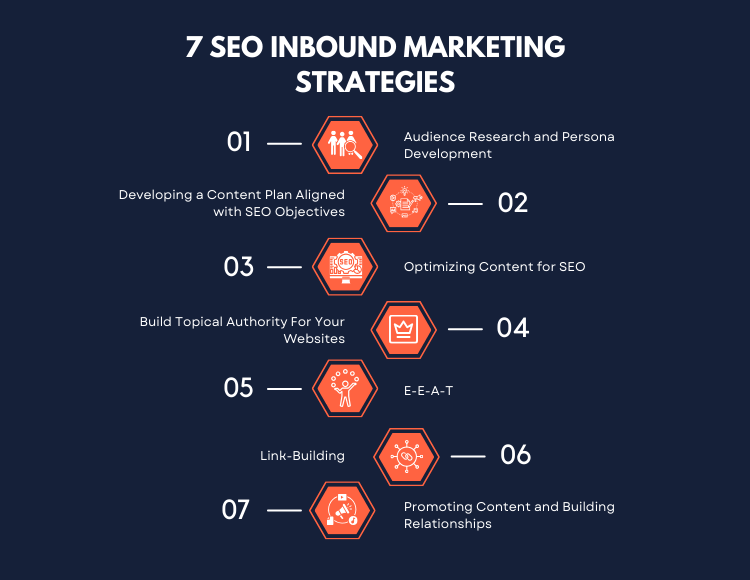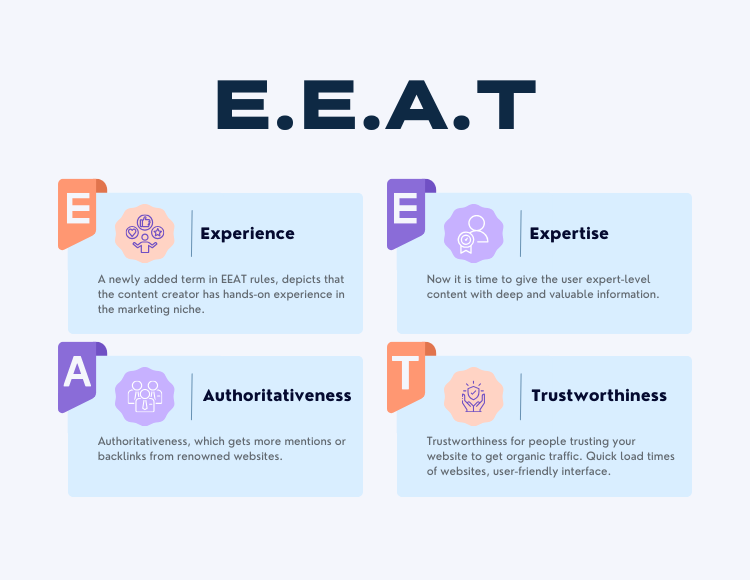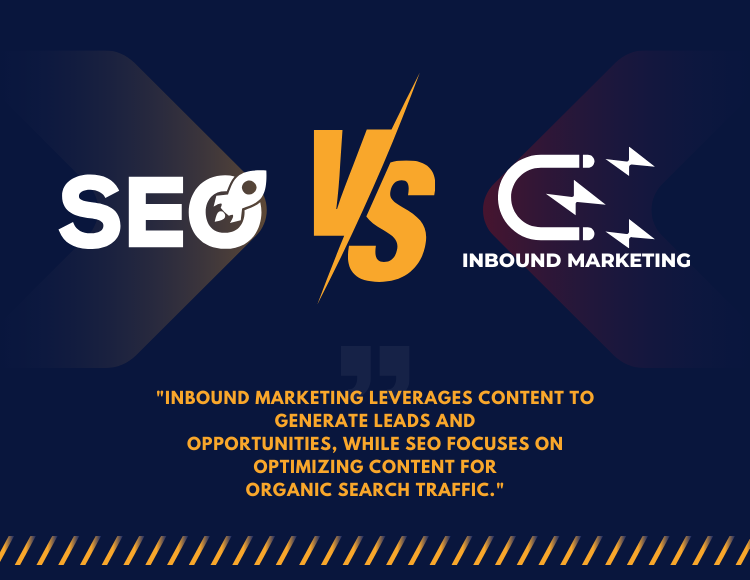
What Is SEO Inbound Marketing? (Inbound Marketing In SEO)
SEO and inbound marketing are two powerful approaches to digital marketing that, when aligned together, bring the most success out of any business. SEO is like fueling an inbound marketing engine.
68% of users’ online experiences start with a search engine, so you can think how inseparable is inbound marketing and SEO.
Specifically, SEO works as the first step of inbound marketing to give content to the right audience, while inbound marketing then makes customers into leads through relevant and valuable information.
But as a marketer, you need to know more about inbound SEO to utilize it properly in your business. How do inbound marketing and SEO work together?
Today, we will discuss all about SEO Inbound Marketing. With benefits and challenges, additionally, there will be 7 Steps to implement inbound marketing strategies for SEO.
What Is Inbound Marketing In SEO?

Technically, SEO is a kind of inbound marketing, and “Content” is the key point that connects these two terms together.
SEO inbound marketing is all about blending the approaches in a systematic way, where SEO brings more visibility to the content that inbound marketing makes by putting all the necessary information for a target audience.
In this approach, inbound marketing stays true to its core principles, along with optimizing its content with SEO to rank higher.
Content is the main point that integrates them. Inbound marketing, marketers make valuable, engaging, relevant content to attract customers. If the content is good quality, SEO helps to improve the visibility on search engines like Google or Bing.
Since inbound marketing works more like local inbound marketing, SEO facilitates the chance to reach a wider audience. Next, an inbound marketing strategy turns the customers into leads. So, the entire process works like a cycle.
Note: However, there are slight differences in algorithms on how to rank on different search engines. Bing counts social media engagement directly, but Google does not.
Since Google dominates the global search market with 83% of searchers, most marketers focus on that.
Why is SEO important in Inbound Marketing?
When inbound marketing effortlessly makes attractive content to generate leads, SEO maximizes the chance of reaching a large audience with the right content at the right time.
So, SEO knowledge can play a crucial role in higher ROI. According to Search Engine Journal, 49% of marketers believe that organic search can drive the best ROI.
Moreover, Google updates its algorithm for SEO day by day. So the customer experience becomes better. It is more customer-oriented, and relevancy is the main factor.
If you want to cope with this digitalization, whether it is B2C or B2B inbound marketing, SEO is an essential or integral part of inbound marketing.
Visibility And Organic Traffic
When users are interested in a particular product and search for it, it is SEO that shows the related products. It gives users opportunities to discover brands and engage with content.
Also, statistics show that 75% of people only check the first page of Google after a search.
Again, it works like a technical thing and involves many methods to rank higher.
SEO mainly ensures that your content is visible to users who have a genuine interest in your offerings. All these lead to higher-quality organic traffic toward websites to make the customers into prospects.
Builds Credibility And Trust
Higher search engine rankings can enhance your brand’s credibility and build trust among users. For making leads, customers need to trust your brand strongly.
Most of the purchasers blindly trust pages that appear first. Mostly because Google itself ranks the authentic pages only.
Statistic: According to a study by Moz, 70-75% of users focus on organic results, ignoring paid advertisements.
Targeted Audience
SEO monitors website traffic, user behavior, searching habits, conversion rate, and demographics and aligns with relevant content to show visitors. You do not need to put in extra effort except by applying the right content marketing approach.
Google’s algorithms and techniques like local SEO, Google My Business, or NAP optimization help to reach out to the right people.
SEO involves understanding user search intent and creating content that addresses their needs and queries. This alignment enhances the user experience, as visitors find exactly what they’re looking for when they land on your website.
SEO is also indirectly related to social media, so you can use hyperlocal social media marketing to reach your segmented audience too.
Quality Content Amplification
Quality Content Amplification in SEO helps the strategic promotion and distribution of high-quality content to reach relevant audiences.
SEO mostly depends on quality content. If you have meaningful, niche-related content, SEO broadly increases interaction with your content to drive traffic, brand awareness, and, ultimately, conversions.
Long Term Result
Search Engine Optimization provides a long-lasting impact on marketing online presence. A well-optimized, structured content can generate organic traffic for years. All your efforts and investment can help you in the long run with SEO.
Statistic: A survey by Conductor found that 64% of marketers indicated that SEO and organic search provide the most valuable leads, surpassing other methods.
How Inbound Marketing Impacts SEO
SEO feeds on content, meaning the core of SEO is relevant content. Content can be anything like blog posts, articles, videos, pictures, statistics, etc.
The main concept of inbound marketing is to drive consumers again with content. This strategy puts most of its efforts into making valuable, educative content and feeds to SEO.
So, inbound marketing and SEO are closely related to each other. Both have a strong impact on each other’s strategy.
You can not ignore one of these techniques to get the most success. There is a lot of debate over Inbound Marketing vs. SEO, which is pointless, actually.
Marketers can only rely on SEO inbound marketing to achieve a successful business.
7 Steps to Implement Inbound Marketing Strategies for SEO

Follow these impactful 7 steps to implement inbound marketing strategies for SEO.
1. Audience Research and Persona Development
To implement an inbound marketing strategy for SEO, the first step is to research the audience and find out persona profiles. 39% of purchasers are triggered by relevant searches while searching for a product, which makes it important to research the audience.
There is no more time when keyword stuffing is the ultimate goal. Now, users’ behavior rules the entire search engine. So, first, understand your target audience’s needs, preferences, pain points, and behaviors.
Use analytics tools, Google search bar, and Google trends to find out what topic people are searching for most.
You can collect information from social media platforms where you promote your products because social media plays an important role in inbound marketing.
Start by seeking answers to these questions.
- How do people get to know about your website?
- How many customers come and take action?
- How many re-purchases, and which product sold the most?
- What age do people most visit your website?
- The content type that drives most of the attention.
Then, create detailed buyer personas that represent different segments of your audience. Knowing these personas allows you to customize your content and messaging in a way that connects with your target customers.
Only by working with a target audience can SEO help to rank higher, which makes it different from traditional outbound marketing.
2. Developing a Content Plan Aligned with SEO Objectives
Once you are done with developing buyers’ persona, it is time to make a content plan aligned with the SEO objective. Go through the following steps.
- Research keywords related to your niche.
- Make an outline of the topics.
- Find what type of content is working best for you and focus on those mainly.
- Optimize your content according to SEO perspective.
- Try to cover blog posts or videos addressing customers’ pain points.
- Make a schedule for publishing and stay consistent. Like regular updates, blog posts on websites increase search traffic by 146%.
- Use different analytical tools to monitor mentions, likes, comments, and shares.
- Utilize an inbound social media marketing strategy to promote your content.
3. Optimizing Content for SEO
Optimizing content is the key element of an effective SEO inbound marketing strategy. You need to follow some rules and tactics according to the Google update.
- Keyword Research
You have come across the term “keyword research” several times from the beginning. This is because keywords are most important for SEO and online visibility.
You need to find the right keyword that can work for you. Search for keywords with high volume but low difficulties. Keyword distribution should be even throughout your whole content, from heading, title, meta description, and whole article.
Search for low-competitive keywords because there is a high possibility of ranking high.
Bonus Tip: Search in different queries where users share their pain points and seek solutions or new topics. Collect keywords from there relatable to your niche.
- Optimize title and headings for SEO
Eye-catching titles are the best to attract customers since they appear first. There are certain rules while writing titles so Google can understand its intent.
Use keywords in your title and heading, and try to keep it within 60 to 70 characters. There is a 57% more chance that Google rewrite the title tags. Keep the title unique, and add relevant words that clarify the intent.
According to Google’s new update, headings should be like that and summarize the whole paragraph under it.
- Content Tags
Be careful about the content tags, like using the correct heading. The title should be tagged with H1; other headings can be H2, H3, H4, etc. Do not mess up with the format, and keep standard font size.
- Descriptions
Meta descriptions appear right below the title link that shows on the search page. Make the description compact with a small summary of your content. Google typically shortens descriptions to about 150-160 characters in its snippets. So, keep this limit in mind. But if you find it hard to keep descriptions within the specified limit, then you can condense them through an AI Summarizer.
- Links
Internal linking and external linking are other parameters of SEO content. Google monitors website authenticity with proper linking.
Add links from trustworthy sites that provide information your reader may seek. It should be in a natural tone and relevant.
- Avoid Plagiarism
Google has great tools for detecting copy-text duplication, and hate duplication most. Try to write blogs or make content without copying from anywhere. It would be best to write from user experience in a human-friendly tone.
Also, use tools like Grammarly to detect plagiarism in your writing.
4. Build Topical Authority For Your Websites
Building topical authority in SEO inbound marketing refers to making search engines understand your website niche. Make your website a reputable and authoritative source in your industry or specialized area.
Topical authority is mainly acquired by covering a particular topic deeply, which shows you are an expert in this field rather than those who chose to work with individual keywords.
Consistently produce high-quality content that demonstrates your expertise and attracts both readers and search engines. Over time, this helps improve your website’s rankings and credibility.
5. E-E-A-T in SEO
The EEAT rules are a concept often discussed in the context of Google’s search algorithms. Higher EEAT showcases why people choose your site among other competitors. Even Google loves sites promoting high EEAT rates.
It stands for Experience, Expertise, Authoritativeness, and Trustworthiness.

Experience, a newly added term in EEAT rules, depicts that the content creator has hands-on experience in the marketing niche or has come from that niche-related background.
With the experience of achieving the Expertise, now it is time to give the user expert-level content with deep and valuable information.
The next phase is Authoritativeness, which gets more mentions or backlinks from renowned websites.
Finally, Trustworthiness for people trusting your website to get organic traffic. Quick load times of websites, user-friendly interface, high security of websites domain with a full page Terms and Conditions can gain high trust from users.
6. Niche Relevant Link Building
High-quality backlinks from reputable and relevant websites carry more weight in terms of SEO benefits.
Google uses backlinks as an important factor in determining a website’s authority. Websites with a good number of quality backlinks rank better.
When an authoritative website links to yours, it shows Google that your site is trustworthy and credible in your niche.
Backlinks also can drive more traffic because only the potential customer tends to click links to know additional information.
7. Promoting Content and Building Relationships
Content promotion is crucial for maximizing your content’s reach. SEO already helps a lot to reach, but still, to gain organic traffic, you can adapt several promotional techniques.
Promote your product or content on different social media channels, email newsletters, and relevant online communities. Whether social media inbound or outbound marketing, it powerfully impacts promoting content.
Respond to comments, give personalized text messages, help them with solutions, and participate in discussions; this can build relationships.
Another way can be collaborating with influencers and other websites in your industry to expand your reach and gain valuable backlinks.
Benefits of Inbound SEO Marketing
For a high increase in revenue, the benefits of SEO inbound marketing are many.
- A data-driven, better user experience oriented.
- SEO inbound marketing generates potential customers.
- It generates more organic traffic, more sales, and more revenue.
- Create more brand awareness and increase visibility.
- Increase ROI.
- Establish a strong relationship between the company and the customer.
- Give the best customer satisfaction.
- Better chance to reach the right audience.
- More cost-effective than traditional outbound marketing.
- SEO inbound marketing is a more reliable and sustainable marketing strategy.
- Helps to increase topical authority.
Common Mistakes in SEO Inbound Marketing
- Working with multiple-niche content.
- Remain inconsistent with content publishing and updates.
- Making duplicate content.
- Not promoting content on social media properly is a common issue of inbound marketing in SEO.
- Incorrect content optimization.
- Targeted Wrong Keywords
How Can SEO and Inbound Marketing Work Together?
By aligning SEO and inbound marketing, it is possible to create a comprehensive online marketing strategy. This fulfills the ultimate goal of organic traffic, building authority, and generating meaningful interactions with potential customers.
Here are some tricks you can use in SEO inbound marketing.
User Experience
SEO focuses on modifying the user experience on your website, which aligns with inbound marketing to provide a seamless buying journey for visitors.
A positive user experience contributes to lower bounce rates and higher engagement. These work as SEO ranking factors.
These factors also include user-friendly, fast, and responsive websites. That should be optimized for different devices, such as mobile responsiveness.
Landing Pages and Conversion Optimization
Inbound marketing often makes landing pages for specific offers, referrals, or campaigns. Here, SEO can optimize these pages for search engines, thereby boosting conversions.
Data Analysis and Optimization
Both strategies use data-driven insights, and data analysis is important to measure the success rate. By monitoring SEO performance metrics and inbound marketing KPIs, easily identify areas for improvement and adjust your approach accordingly.
Backlinks and Authority
Inbound marketing seeks to establish a brand as an industry leader. SEO complements this intent by helping build backlinks from authoritative sources.
Building high-quality backlinks from reputable sources is an important part of SEO.
Inbound marketing efforts that produce valuable content are more likely to gain backlinks from other websites. Which, in return, enhances the website’s authority and credibility in the eyes of search engines.
High-quality Content
Both SEO and inbound marketing rely on high-quality content. This does not mean unnecessary stuffing of keywords.
First, market research deeply about the trending topics. Then try to cover your customer’s pain points, and give solutions to their problems by making video tutorials or how to do articles. Even if you can make videos on how to use your product, what can be the real-life benefits?
Give 24/7 service by using chatbots. Only allow high-quality content, which surely gives you the best result.
What’s The Difference Between SEO and Inbound Marketing

Though SEO Inbound marketing has a significant role in most marketing growth, both terms differ slightly.
SEO primarily focuses only on optimizing websites to rank higher in search engine results for organic traffic. It makes websites more visible to users searching for relevant keywords.
In contrast, inbound marketing is a broader strategy that encompasses SEO but goes beyond it. Inbound marketing works to attract, engage, and delight potential customers. Utilize customers’ buyer journey at every stage.
Also, it involves creating valuable content that meets your target audience’s interests and needs. This ultimately leads to conversions and customer loyalty.
Verdict
SEO inbound marketing is undoubtedly one of this era’s most powerful digital marketing strategies. The integration gives a better opportunity to experience a higher success rate in business.
The main key concept is driving consumers through SEO to the content that inbound marketing efforts create. The approach is simple to understand but can be tricky to acquire.
However, we have shown how to effectively use inbound SEO and the benefits and drawbacks of inbound SEO. In the end, some successful methods of integrating inbound marketing and SEO.
Link nội dung: https://khoaqhqt.edu.vn/inbound-marketing-seo-hot-a46501.html